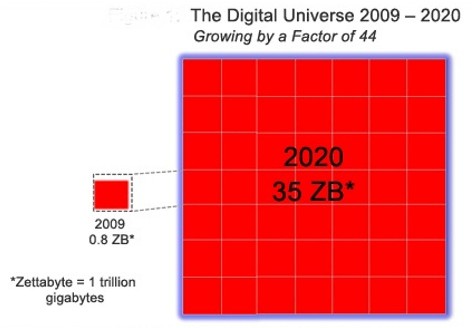|
HOME
Technology Dec 2010 Zeros, ones and zetabytes Content exceeding capacity |
|
“Data creation will double over the next few years leaving EMC and IDC wondering where the 35 percent beyond our current storage capacities will go.” We’re drowning in data and running out of places to store it, according to the latest international research on how much digital information we are creating and copying each year. It seems our desire to take photos, copy music and videos, blog and engage in social networking is outpacing even the astonishing capacity of hard drives, removable storage devices and content servers. In
the fourth annual round-up of how much we are creating EMC Corporation,
in conjunction with research firm IDC, claims digital information grew
by 62 percent in 2009. In 2008 we created and copied 800 billion gigabytes of data and by the end of this year it will reach 1.2 Zettabytes. A Zettabyte is a trillion gigabytes or the equivalent of 75 billion fully loaded 16Gb Apple iPads or a full-length episode of the TV hit series 24 running continuously for 125 million years.
The Digital Universe
Decade - Are You Ready? report says the data we create will
grow by a factor of 44 by 2020 as voice, TV, radio and print complete
the journey from analogue to digital. By then EMC predicts more than a third of all digital information will pass through or be stored by some trusted third party over the internet and need to be managed, secured and protected. More than 70 percent of this data is generated by individuals and social networking and Web 2.0 technologies will continue to drive our digital addictions. Data creation will double over the next few years leaving EMC and IDC wondering where the 35 percent beyond our current storage capacities will go. The phenomenal rise and rise of information creation and storage capacity is amply illustrated by the fact that 3¼ inch floppy disks — essential for 1980s PCs — were finally phased out by Sony this year. Curiously it still sold 12 million in 2009. The 1.44Mb disks were long ago displaced by CDRs, USB flash drives and memory cards. USB thumb drives and SD cards offering 4Gb and beyond now sell for around $20 each. Meanwhile computers hard drives are going through a huge capacity curve with 500Gb being standard last year and 1-2 Terabyte (Tb) internal drives appearing on many computers this year. External drives from Seagate and Western Digital are selling for $100-$200.
Terabyte
SD
cards SanDisk, the global leader in flash memory cards, began shipping 64Gb cards in February doubling the previous 32Gb ceiling. The new Ultra SDXC cards are pitched as the ideal media to store and transfer 1080p HD video files from camera to computer They also target the 32Gb and 128Gb CompactFlash card format used in many camcorders and digital SLR cameras and are the ideal repository for RAW format photos, movie downloads and music files. Sony and SanDisk partnered to embrace the shift in the Memory Stick range and Panasonic announced it would have its first 1Tb SD card on the market by the end of this year, and would double that in 2011.
The new 2000Gb capacity (2 Terabyte) cards could store about 100 HD movies, 480 hours of HD recording or 136,000 high quality photos. They’ll have data transfer speeds of 140Mbit/s but new ‘dual row pin’ memory cards will allow up to 300Mbit/s transfer speeds for all SD and microSD cards, changing the game again. The new high capacity cards will further cement the SD format, with an estimated 2.5 billion cards already shipped, as the industry standard for electronic devices and data transfer.
|
